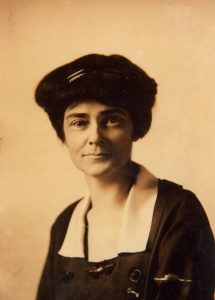(Dec. 23, 1874-May 19, 1928). Clara Burnside was born in Indianapolis to Thomas C. Burnside and Jennie O. Kelly. Her uncle was Civil War Union general Ambrose E. Burnside, for whom the Civil War facility Burnside Barracks was named (see ).
Sometime during her youth, the family moved to Liberty, Indiana, where Burnside graduated from Short High School, on May 20, 1892. She then attended DePauw University, where she belonged to the Iota chapter of the Kappa Kappa Gamma sorority.
Upon graduation from college in 1901, Burnside came to Indianapolis and worked as a social worker. She served as a probation officer two years later when the Marion County Juvenile Court was established on March 24, 1903 (see ). At the request of presiding juvenile court judge Newton M. Taylor, Burnside became chief probation officer on September 19, 1911.
Following the national trend of appointing women to helm police department units aimed at curbing moral crimes, chief selected Burnside as the first female police officer on the force on May 18, 1918.
Reporting directly to Chief Coffin, Burnside was given the rank of sergeant. Coffin appointed 13 female officers on June 15, 1918, to work under her charge. Two of the officers were Black women, and —another progressive move for the police department. The group of women lay their focus on the protection of young girls and the prevention of shoplifting at downtown stores.
Burnside was promoted to the rank of lieutenant on July 13, 1920. Within six months, on March 22, 1921, the Board of Safety of Indianapolis promoted Burnside to the rank of captain. With her promotion, the noted that the department ranked among only two other women’s departments, those in Washington, D.C., and Seattle under the supervision of a woman. Notably, Burnside’s work extended beyond the administrative and supervisory—she actively patrolled the streets with other policewomen.
Burnside’s peers credited the success of the police department’s Women’s Police Bureau largely to her leadership. In 1921, the department boasted 23 policewomen, ostensibly the largest force of female officers in the world. Twelve officers patrolled in pairs, working from 2 p.m. to 1 a.m. The others were given general assignments and investigations.
Though Burnside’s department received praise, Indianapolis mayor abolished the women’s police department in January 1922. He appointed two Indianapolis clubwomen, Emma Rappaport Leiber and Edith May Anthony to investigate the juvenile protective associations in Chicago, Cincinnati, and Louisville, as well as the departmental workings of Indianapolis’ female police department. From these observations, the two clubwomen made three recommendations for the improvement of Burnside’s department in March 1922. First, they proposed the formation of a juvenile protective association in Indianapolis. All investigations and protective work would be assigned to policewomen. Second, they recommended a condensed department of women to attack the increasing problem of theft among women and children. All policewomen, except the three matrons at the city prison and the four policewomen in the detective department, would report to Burnside, who in turn would report directly to Chief Herman F. Rikhoff. Third, Burnside’s team would monitor all juvenile venues such as dance halls. Implementation of these recommendations resulted in the reduction of Burnside’s rank to sergeant.
Burnside’s new appointment included oversight of investigations of juvenile court cases, one policewoman assigned to the , and all Black policewomen who patrolled their communities. In all, Burnside and her division oversaw all juvenile locales. These included dance halls, theaters, parks, train stations, and public amusements. These venues were thought to contribute to the delinquency of children.
Burnside resigned from the police department on October 31, 1922. She and Chief Rikhoff had maintained a cordial working relationship, but Burnside decided to accept a position as an adult probation officer at the Marion County Juvenile Court. Within a year, Burnside was promoted to case supervisor.
Before she died in 1928, many public safety officials and social welfare advocates recognized Burnside as a pioneer in affairs relating to policewomen and the social welfare system of the city, both in the courts and in the police department.
She was a member of the Indianapolis chapter of the American Association of Social Services, the National Probation Society, and the Indianapolis Social Workers’ Club.

Help improve this entry
Contribute information, offer corrections, suggest images.
You can also recommend new entries related to this topic.





